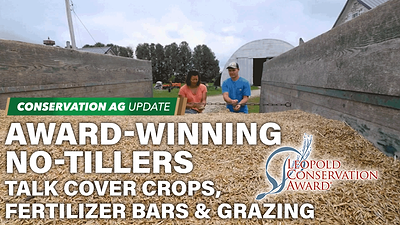James Houghton, an English dairy farmer, is interseeding field beans in corn with the goal of enhancing the protein content of feed and reducing his fertilizer costs.
West Park Farm in Dorset, owned by the Houghton family, is a 445-acre dairy farm with 200 milking cows. The farm also serves as a grass and corn silage contracting business. Houghton's corn yields average 237.91 bushels per acre with its peak at 282.52 bushels per acre last year.
Corn Planted First
Last planting season, Houghton interseeded a 40-acre field of corn with 4 different grass species: Italian ryegrass, cocksfoot, meadow fescue, festuloium and fescue. He wanted to determine the effects on soil erosion and nitrogen leaching. He interseeded 3 rows of grass between the corn when it was at at the four-leaf stage.
Houghton's first round of interseeding corn with grass was a success, so this year, he's growing a protein source — field beans. He tried strip-till for the first time this year, using a Kuhn Striger strip-till drill to plant about 129 acres of corn.
"One-third of crops were planted using the strip-till drill, which has saved us a significant 3.5 litres/ha of fuel, down from 8 litres/ha with the plough and power harrow," says Houghton. "Not only does this save fuel, but it also reduces labour costs and means we're doing our bit for the environment."
Bean Variety Choice
Houghton talked with his agronomist to find the right species and variety of field bean to interseed with the maize. They decided on Maris Bead for its good protein source, energy content and downy mildew resistance. The variety ranks as an 8 out of 9 for mildew resistance.
Field beans emerge slowly and are vulnerable to weed invasion, so he needed a variety strong enough to establish in a standing crop of corn. In addition, this variety provides early ripening and grows to about 47 inches tall, which means both crops can be harvested together with a corn chopper header.
Bean Establishment
Houghton planted field beans into about 86 acres of standing 30-inch-row corn shortly before the corn hit the four-leaf stage. He interseeded 3 rows of beans between the corn rows using a Weaving inter-row drill. The seeding rate was just under 25.5 pound per acre with seeds planted about 2 inches deep.
The corn received about 107.1 pounds per acre of nitrogen (H), but Houghton hopes to reduce that rate in the future because the beans should fix more N.
One setback he encountered with interseeding beans was the lack of chemistry for weed control. He's hoping the canopy closes fast enough to prevent weeds from taking hold. Last year, his grass established quickly enough and with good ground cover to prevent weeds from emerging.






